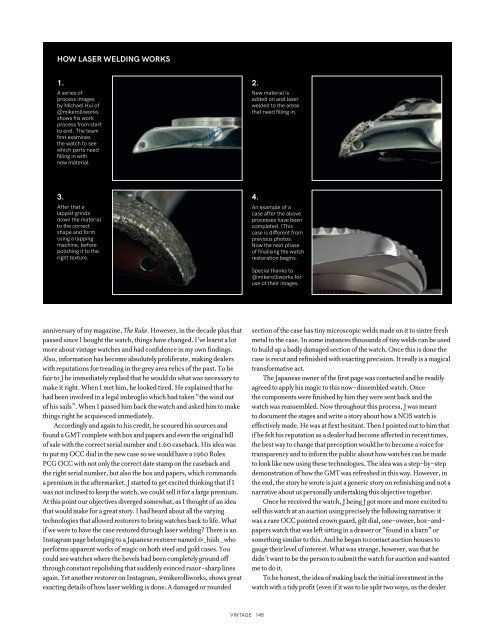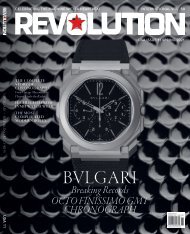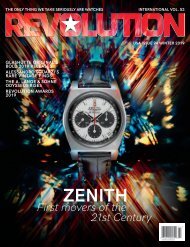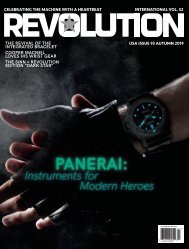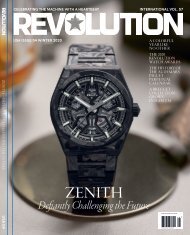Create successful ePaper yourself
Turn your PDF publications into a flip-book with our unique Google optimized e-Paper software.
HOW LASER WELDING WORKS<br />
1.<br />
A series of<br />
process images<br />
by Michael Hui of<br />
@mikerolliworks<br />
shows his work<br />
process from start<br />
to end. The team<br />
first examines<br />
the watch to see<br />
which parts need<br />
filling in with<br />
new material.<br />
2.<br />
New material is<br />
added on and laser<br />
welded to the areas<br />
that need filling in.<br />
3.<br />
Afterthata<br />
lappist grinds<br />
down the material<br />
to the correct<br />
shape and form<br />
using a lapping<br />
machine, before<br />
polishing it to the<br />
right texture.<br />
4.<br />
An example of a<br />
case after the above<br />
processes have been<br />
completed. (This<br />
case is different from<br />
previous photos.<br />
Now the next phase<br />
of finalising the watch<br />
restoration begins.<br />
Special thanks to<br />
@mikerolliworks for<br />
useoftheirimages.<br />
anniversary of my magazine, The Rake. However, in the decade plus that<br />
passed since I bought the watch, things have changed. I’ve learnt a lot<br />
more about vintage watches and had confidence in my own findings.<br />
Also, information has become absolutely proliferate, making dealers<br />
with reputations for treading in the grey area relics of the past. To be<br />
fair to J he immediately replied that he would do what was necessary to<br />
make it right. When I met him, he looked tired. He explained that he<br />
had been involved in a legal imbroglio which had taken “the wind out<br />
of his sails”. When I passed him back the watch and asked him to make<br />
things right he acquiesced immediately.<br />
Accordingly and again to his credit, he scoured his sources and<br />
found a GMT complete with box and papers and even the original bill<br />
of sale with the correct serial number and 1.60 caseback. His idea was<br />
to put my OCC dial in the new case so we would have a 1960 Rolex<br />
PCG OCC with not only the correct date stamp on the caseback and<br />
the right serial number, but also the box and papers, which commands<br />
a premium in the aftermarket. J started to get excited thinking that if I<br />
was not inclined to keep the watch, we could sell it for a large premium.<br />
At this point our objectives diverged somewhat, as I thought of an idea<br />
that would make for a great story. I had heard about all the varying<br />
technologies that allowed restorers to bring watches back to life. What<br />
if we were to have the case restored through laser welding? There is an<br />
Instagram page belonging to a Japanese restorer named @_hiiih_ who<br />
performs apparent works of magic on both steel and gold cases. You<br />
could see watches where the bevels had been completely ground off<br />
through constant repolishing that suddenly evinced razor-sharp lines<br />
again. Yet another restorer on Instagram, @mikerolliworks, shows great<br />
exacting details of how laser welding is done. A damaged or rounded<br />
section of the case has tiny microscopic welds made on it to sinter fresh<br />
metal to the case. In some instances thousands of tiny welds can be used<br />
to build up a badly damaged section of the watch. Once this is done the<br />
case is recut and refinished with exacting precision. It really is a magical<br />
transformative act.<br />
The Japanese owner of the first page was contacted and he readily<br />
agreed to apply his magic to this now-dissembled watch. Once<br />
the components were finished by him they were sent back and the<br />
watch was reassembled. Now throughout this process, J was meant<br />
to document the stages and write a story about how a NOS watch is<br />
effectively made. He was at first hesitant. Then I pointed out to him that<br />
if he felt his reputation as a dealer had become affected in recent times,<br />
the best way to change that perception would be to become a voice for<br />
transparency and to inform the public about how watches can be made<br />
to look like new using these technologies. The idea was a step-by-step<br />
demonstration of how the GMT was refreshed in this way. However, in<br />
the end, the story he wrote is just a generic story on refinishing and not a<br />
narrative about us personally undertaking this objective together.<br />
Once he received the watch, J being J got more and more excited to<br />
sell this watch at an auction using precisely the following narrative: it<br />
was a rare OCC pointed crown guard, gilt dial, one-owner, box-andpapers<br />
watch that was left sitting in a drawer or “found in a barn” or<br />
something similar to this. And he began to contact auction houses to<br />
gauge their level of interest. What was strange, however, was that he<br />
didn’t want to be the person to submit the watch for auction and wanted<br />
me to do it.<br />
To be honest, the idea of making back the initial investment in the<br />
watch with a tidy profit (even if it was to be split two ways, as the dealer<br />
VINTAGE 145


